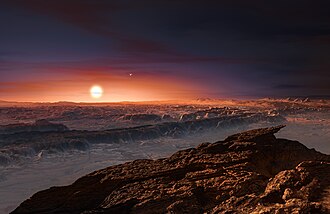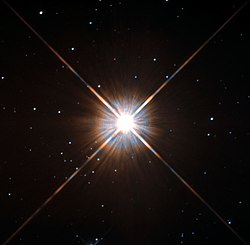Proxima Centauri
Proxima Centauri is a red dwarf star that is likely a part of the Alpha Centauri star system and is the closest star to the Sun at a distance of 4.22 light-years (3.99×1013 km; 2.48×1013 mi). It is in the constellation of Centaurus.
Proxima Centauri was found to share the same proper motion as Alpha Centauri in 1915 by Robert Innes while he was Director of the Union Observatory in Johannesburg, South Africa.
In 1951, Harlow Shapley said that Proxima Centauri was a flare star. Recorded photographs showed that the star became measurably brighter about 8% of the time, making it the most active flare star then found.
Characteristics
Red dwarfs are usually far too faint to be seen with the naked eye, that means without a telescope. Proxima Centauri has an apparent magnitude of 11 while its absolute magnitude is a very dim 15.5. Even from Alpha Centauri A or B, Proxima would only be seen as a 5th magnitude star.
Proxima Centauri has been the closest star to the Sun for about the last 32,000 years. Barnard's Star will make its closest approach to the Sun around AD 11,700, when it approaches to within about 3.8 light-years.[1] However, at that time, it will not be the nearest star, since Proxima Centauri will then have moved even closer to the Sun.[2] Six stars will come closer to Earth in the next 45,000 years.[3]
Planetary system

In 2016, an exoplanet was found by the European Southern Observatory around Proxima Centauri, Proxima Centauri b (or Proxima b). It was found in the habitable zone, and was thought to be Earth-like, with an ESI of 0.87.[4] While being Earth-like, it may not be habitable on the surface, since Proxima Centauri gives off strong solar flares and high solar winds, which could strip away parts of the atmosphere of the planet, making it less habitable.[5]
In October of 2016, scientists at France's CNRS research institute said that the planet may have oceans on its surface, and a thin atmosphere. If this idea is true or not is not known.[6]
Another planet, Proxima Centauri c, much farther out than b, was discovered in 2019.[7] It is seven times heavier (more massive) than Earth. It is too cold to be habitable. Because it showed up brighter than expected when photos of it were taken, it may have a ring system five times wider than that of Jupiter.
Proxima Centauri Media
Relative sizes and colour of the Alpha Centauri A, B and C (Proxima) and other local stars, incl. the Sun and Jupiter for comparison (artist's impression)
Alpha Centauri A and B are the bright apparent star to the left, which are in a triple star system with Proxima Centauri, circled in red. The bright star system to the right is the unrelated Beta Centauri.
Proxima Centauri (unlabeled) next to Alpha Centauri on a radar map of all known stellar and substellar objects within 9 light years (ly), arranged clockwise in hours of right ascension, and marked by distance (▬) and position (◆)
Schematic of the three planets (d, b, and c) of the Proxima Centauri system, with the habitable zone identified
Overview and comparison of the orbital distance of the habitable zone
Related pages
References
- ↑ García-Sánchez, J. (2001). "Stellar encounters with the solar system". Astronomy & Astrophysics. 379 (2): 642. Bibcode:2001A&A...379..634G. doi:10.1051/0004-6361:20011330. S2CID 52952019.
- ↑ Matthews R.A.J.; et al. (1994). "The close approach of stars in the solar neighborhood". Quarterly Journal of the Royal Astronomical Society. 35: 1–9. Bibcode:1994QJRAS..35....1M.
- ↑ Same source: The close approach of stars in the Solar neighborhood. Matthews R.A.J. 1994. Quarterly Journal of the Royal Astronomical Society, 35, #1, p1.
- ↑ http://phl.upr.edu/press-releases/proxb Archived 2019-05-02 at the Wayback Machine | A Potentially Habitable World in Our Nearest Star | Aug 17, 2016
- ↑ https://www.space.com/39829-nearest-exoplanet-proxima-b-superflare.html | Superflare Blasts Proxima b, the Nearest Exoplanet, Dimming Hopes of Life | By Mike Wall | February 28, 2018
- ↑ "Planet in star system nearest our Sun 'may have oceans'", Phys.org, Retrieved 6 October 2016
- ↑ Billings, Lee (April 12, 2019). "A Second planet may orbit Earth's nearest neighboring star". Scientific American. https://www.scientificamerican.com/article/a-second-planet-may-orbit-earths-nearest-neighboring-star/. Retrieved April 12, 2019.









